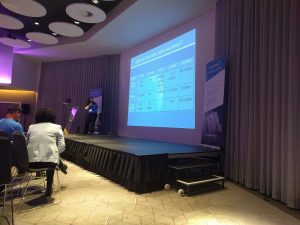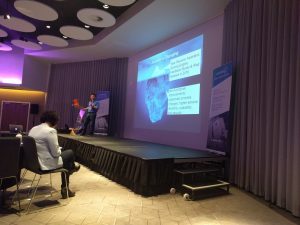On Thursday 6th October, I attended the Turnitin User Summit in Newcastle. The one day event consisted of short presentations from Turnitin representatives, guest speakers from UK HE institutions, a group workshop and a ‘knowledge bar’ which provided an opportunity to speak to a variety of people working at Turnitin. Before I discuss the event, here are some pictures from my time in Newcastle.




Newcastle, for those who have not been, is a Northern city (closer to Edinburgh than London) dominated by a number of bridges over the Tyne, a plethora of bars and clubs, an average football club and two very central universities (Newcastle and Northumbria). Incidentally, my trip coincided with freshers’ week so I spent most of Wednesday evening dodging drunk students dressed as gladiators, knights and Harry Potter.
Hello from the CEO
The user summit took place in the rather nice surroundings of the Crowne Plaza in Newcastle. After the customary coffee, pastries and meet and greet, the event kicked off with a video from the CEO Chris Caren, who discussed recent successes and outlined his vision for Turnitin. Future aims include increasing the number of submissions to one billion (currently at 636 million), tripling the number of unique users to reach 100 million learners and improve the ‘journey’ for students submitting drafts. For instance, students submitting formative drafts with have full online feedback and not just an originality report. Turnitin are also working on a ‘ghost writing’ build to recognise if someone else is writing your essay.
Recent successes for Turnitin include doubling the customer support staff and introducing the ‘wizard’ support feature. Moreover, the introduction of the wizard has seen a vast reduction in support queries (specifically related to forgetten passwords). With the increase in support staff, Turnitin hope to have an SLA of 24 hours by next year. However, with the goal of having 100 million learners and a billion submissions, I am little sceptical if they can realistically achieve this target. In terms of hosting, another success has been the move to Amazon Web Service (AWS). According to Caren, the move has helped improve up-time and greatly improved security and flexibility. Finally, the welcome ended with a note on how important the UK market is for Turnitin. He used the example of multiple markers being a huge requirement in UK and so far they have failed to deliver on this. The company hope to tailor the product more to the needs of regions once they role out Feedback Studio next year.
Customer-Centric Vision
Following the CEO was a presentation by Claudia Dowell from Turnitin on the ‘customer-centric vision’ of the company. After looking back at the successes over an 18 year period and comparsions against rivals (see image below), Claudia noted that communication between Turnitin and users is not great and needs to be improved. One of the methods suggested to improve communication is to build a user community. I suggested to the VP of Turnitin that they should look at Behind the Blackboard as a template for how it could be set out. It seems that there was a big demand from those who attended the summit for the development of a community.

Technology Keynote
Ron Park, CTO of Turnitin, began his presentation by noting that the company had over promised and under delivered in the past. He argued the key for the future success of Turnitin is to improve speed, power, flexibility, accessibility and security. To help reach these five goals, the company have made many improvements, including investing in a new $5 million Data Centre. Ron used the analogy of an iceberg to demonstrate some of the other big changes happening within the company (see image below).

Feedback Studio
One of the main reasons for attending this summit was the opportunity to view Feedback Studio in action. Mark Rickson, one of the chief designers of Feedback Studio, was on hand to demo the system and run through some of the main features.
One of the new features has been the development of a web crawler called ‘Walker’ (Turnitin trying to be funny with the name…). A web crawler is what Turnitin use to scan and index new and existing content from the web in the Turnitin database. The problem with the previous crawler was it did not go deep into web content and struggled with java script content. Furthermore, it previously could not crawl SSL secured pages. Walker on the other hand can crawl SSL pages and is also significantly quicker. For example, previously it would take 17 days to crawl through the whole of Wikipedia. The same process can now take place in 5 hours.
The main goal for the designers of Feedback Studio has been to make it easier to use (for both staff and students) than previous versions of Turnitin. In particular, they have put a lot of effort into re-jigging the interface when providing student feedback. In Turnitin Classic, you have different feedback options in every corner of the page. Feedback Studio on the other hand consolidates all the options into one tool bar at the side of the page. You can view this and other changes in the demo video below;
https://www.youtube.com/watch?v=tIKjBzJIe2g
Edinburgh University gave a short presentation discussing their findings on using Feedback Studio. Edinburgh have been involved in the beta testing and have been using the system for the last four months. To date, there have been 5952 submissions using Feedback Studio. User consultation has proved positive and despite having the option to revert back to Turnitin Classic, Edinburgh have found that users are sticking with Feedback Studio. In addition, 85/90% of their users use Feedback Studio with the Blackboard Learn integration. Rather positively, they haven’t reported any issues with this.
Nevertheless, despite the positivity surrounding Feedback Studio, Turnitin still have not addressed some key requirements that users would like to see in the new system. There still appears to be no delegated grading or option for double and blind marking. This seemed to be a concern for most users at the summit. On a positive note, they have recognised this is an important issue and are in the process of developing a solution to support multiple and blind marking. Turnitin are currently looking for beta testers for this. Information on this can be found here – https://guides.turnitin.com/01_Manuals_and_Guides/Feedback_Studio_Success_Kit/Multiple_Markers_(Beta). Realistically, it will probably be a couple of years before these features are included in Feedback Studio.
Feedback Studio – Launch Timeline
In August 2017, Feedback studio will become the default service, as Turnitin classic is fully deprecated. To help users with the transition to Feedback Studio, Turnitin have created a Success Kit (https://guides.turnitin.com/01_Manuals_and_Guides/Feedback_Studio_Success_Kit) which contains resources needed to get started with the new system. This includes a section on how to trial Feedback Studio with a subset of users and email templates to send to staff.
All in all, it was a useful conference to attend. Turnitin seem keen to keep their UK customers happy and they hope the introduction of the Feedback Studio and a potential user community will help them achieve this. However, it was also somewhat dissappointing that they have not addressed the issue of delegated, multiple or blind marking. There is clearly is a huge demand for these features so hopefully they will appear at some point in Feedback Studio. If they don’t, I’m sure any new community of users will have a lot to say on the matter.